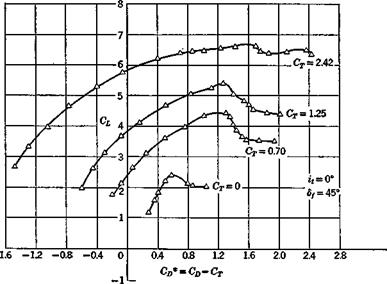EFFECTS ON THE TAIL
The propeller slipstream can affect the tail principally in two ways. (1) Depending on how much if any of the tail lies in it, the effective values of at and ae will experience some increase. (2) The down wash values €0 and de/да may be appreciably altered in any case. Methods of estimating these effects are at best uncertain, and powered-model testing is needed to get results with engineering precision for most new configurations. However, some empirical methods (refs. 7.8 to 7.10) are available that are suitable for some cases.
EXAMPLE OF PROPELLER EFFECT
Figure 7.6 shows the large effects of thrust on a deflected-slipstream STOL configuration. The data presented are from wind-tunnel tests reported in
|
|
|
(b) |
ref. 7.11. The configuration has two tractor propellers, full-span double slotted flaps deflected 45°, and a high tail. The drag coefficient Gjy plotted on Fig. 7.66 is the net streamwise force, and includes the thrust as a negative drag. The effect of the slipstreams on the downwash was large. For the case shown, 9e/9a increased by 100% between GT = 0 and 1.25. At the same time CL increased from.068 to.130. A large decrease in static margin at a = 0 due to adding thrust is found from the data:
|
Gm |
.025 |
|||
|
= 0 : |
кп = – |
ma _ |
—– = |
= .37 |
|
GT "a |
.068 |
|||
|
Cm |
.0120 |
|||
|
= 1.25: |
Kn = |
ma _ |
= .09 |
|
|
cL |
.130 |
|
This represents a forward movement of the N. P. of 28% c. |













